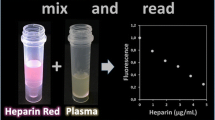Abstract
There are several methods for sensitive detection of oversulfated chondroitin sulfate (OSCS) in heparin. Although contamination with OSCS is unlikely to be repeated, use of other compounds to counterfeit heparin must be considered. We have previously developed a two-step fluorescence microplate assay (two-step FI assay) for detection of OSCS. First, the heparin sample is incubated with heparinase I, then its increasing effect on the fluorescence intensity (FI) of the sensor molecule Polymer-H is measured (PolyH assay). The high sensitivity of the assay is shown to be based on heparinase I inhibition by OSCS. The objective of this study was to evaluate another assay option — indirect quantification of OSCS after heparinase I incubation by means of the anti-Factor Xa (aXa) activity of the remaining undegraded heparin (two-step aXa assay). We also examined, whether other heparin mimetics (HepM), direct Factor Xa inhibitors (DXI), and protein impurities are detectable by use of these assays. Heparin was spiked with different amounts of HepM including OSCS, pentosan polysulfate, dextran sulfate, curdlan sulfate, the natural contaminant dermatan sulfate, the DXI rivaroxaban, and BSA as a protein. These samples were compared with pure heparin in the two-step FI assay, the two-step aXa assay, and in the PolyH assay and the aXa assay without heparinase I incubation. Both two-step assays sensitively measured contamination with all the HepM (LOD ≤ 0.5%, LOQ ≤ 0.7%). The two-step aXa assay also detected rivaroxaban (LOD 0.3%, LOQ 0.4%), whereas the two-step FI assay was shown to be suited to determination of protein impurities (LOD 0.11%, LOQ 0.13%). Use of two different heparinase I inactivation procedures enabled clear differentiation between protein, HepM, and both contaminants. Finally, with the aXa assay the heparin potency can be determined in the same assay run, whereas the FI increase in the PolyH assay was shown to be useful for identification. In conclusion, both the two-step FI assay and the two-step aXa assay are sensitive, rapid, and simple tests for the detection of counterfeit heparin. Comprehensive information about heparin quality can be obtained by their combined use and the parallel measurement of non-incubated heparin samples.





Similar content being viewed by others
References
FDA U.S. Food and Drug Administration (2009) http://www.fda.gov/Drugs/DrugSafety/PostmarketDrugSafetyInformationforPatientsandProviders/ucm112669.htm. Accessed 05 March 2010
Alban S (2010) Pharm Ztg 12:14–22
Guerrini M, Beccati D, Shriver Z, Naggi A, Viswanathan K, Bisio A, Capila I, Lansing JC, Guglieri S, Fraser B, Al-Hakim A, Gunay NS, Zhang Z, Robinson L, Buhse L, Nasr M, Woodcock J, Langer R, Venkataraman G, Linhardt RJ, Casu B, Torri G, Sasisekharan R (2008) Nat Biotechnol 26:669–675
N.N. Heparin sodium. Stage 2 (2009) US Pharmacopoeia, Rockville. http://www.usp.org/hottopics/heparin.html. Accessed 05 July 2010
EDQM (2010) EDQM What’s new? Heparin monographs. Heparin sodium & Heparin calcium. http://www.edqm.eu/en/Whats_new-525.html. Accessed 05 March 2010
Pan J, Qian Y, Zhou X, Pazandak A, Frazier SB, Weiser P, Lu H, Zhang L (2010) Nat Biotechnol 28:203–207
Guerrini M, Shriver Z, Naggi A, Casu B, Linhardt RJ, Torri G, Sasisekharan R (2010) Nat Biotechnol 28:207–211
Guerrini M, Zhang Z, Shriver Z, Naggi A, Masuko S, Langer R, Casu B, Linhardt RJ, Torri G, Sasisekharan R (2009) Proc Natl Acad Sci USA 106:16956–16961
Keire DA, Mans DJ, Ye H, Kolinski RE, Buhse LF (2010) J Pharm Biomed Anal 52:656–664
Bairstow S, McKee J, Nordhaus M, Johnson R (2009) Anal Biochem 388:317–321
Tami C, Puig M, Reepmeyer JC, Ye H, D’Avignon DA, Buhse L, Verthelyi D (2008) Biomaterials 29:4808–4814
Alban S, Lühn S (2008) N Engl J Med 359:2732–2734
Lühn S, Schiemann S, Alban S (2010) Anal Bioanal Chem. doi:10.1007/s00216-010-3867-5, Online First 16.06.10
Lühn S, Schrader T, Sun W, Alban S (2010) J Pharm Biomed Anal 52:1–8
Sun W, Bandmann H, Schrader T (2007) Chemistry 13:7701–7707
van Herpen R (2010) 4th Workshop on the Characterisation of Heparin Products, http://www.hpa-events.org.uk/hpa/frontend/reg/tOtherPage.csp?pageID=50747&eventID=111. Accessed 29 July 2010
N.N. (2008) European Pharmacopoeia 60 01/2008:0828
Maruyama T, Toida T, Imanari T, Yu G, Linhardt RJ (1998) Carbohydr Res 306:35–43
Alban S, Franz G (2001) Biomacromolecules 2:354–361
ICH harmonized tripartite guideline, Validation of analytical procedures: text and methodology Q2 (R1) Current Step 4 version 2005, http://www.ich.org/cache/compo/363-272-1.html. Accessed 23 July 2010
Alban S, Schiemann S (2009) J Thromb Haemost 7:Abstract PP-WE-506
Rej RN, Ludwig-Baxter KG, Perlin AS (1991) Carbohydr Res 210:299–310
Neville GA, Mori F, Holme KR, Perlin AS (1989) J Pharm Sci 78:101–104
Linhardt RJ, Gunay NS (1999) Semin Thromb Hemost 25(Suppl 3):5–16
Liverani L, Mascellani G, Spelta F (2009) Thromb Haemost 102:846–853
Beyer T, Matz M, Brinz D, Radler O, Wolf B, Norwig J, Baumann K, Alban S, Holzgrabe U (2010) Eur J Pharm Sci 40:297–304
Alban S, Lühn S, Schiemann S, Beyer T, Norwig J, Schilling C, Rädler O, Wolf B, Matz M, Baumann K, Holzgrabe U (2010) Anal Bioanal Chem. doi:10.1007_s00216-010-4169-7, Online First 08.09.10
de Candia M, Lopopolo G, Altomare C (2009) Expert Opin Ther Pat 19:1535–1580
Perzborn E, Roehrig S, Straub A, Kubitza D, Mueck W, Laux V (2010) Arterioscler Thromb Vasc Biol 30:376–381
Wang Y (2010) 4th Workshop on the Characterisation of Heparin Products, http://www.hpa-events.org.uk/hpa/frontend/reg/tOtherPage.csp?pageID=50747&eventID=111. Accessed 29 July 2010
Acknowledgments
We acknowledge Professor Thomas Schrader and Dr Wei Sun for supply of the Polymer-H and Dr Dennis Schade for support in OSCS synthesis.
Author information
Authors and Affiliations
Corresponding author
Additional information
Published in the special issue Heparin Characterization with Guest Editor Cynthia K. Larive.
Rights and permissions
About this article
Cite this article
Alban, S., Lühn, S. & Schiemann, S. Combination of a two-step fluorescence assay and a two-step anti-Factor Xa assay for detection of heparin falsifications and protein in heparins. Anal Bioanal Chem 399, 681–690 (2011). https://doi.org/10.1007/s00216-010-4252-0
Received:
Revised:
Accepted:
Published:
Issue Date:
DOI: https://doi.org/10.1007/s00216-010-4252-0




